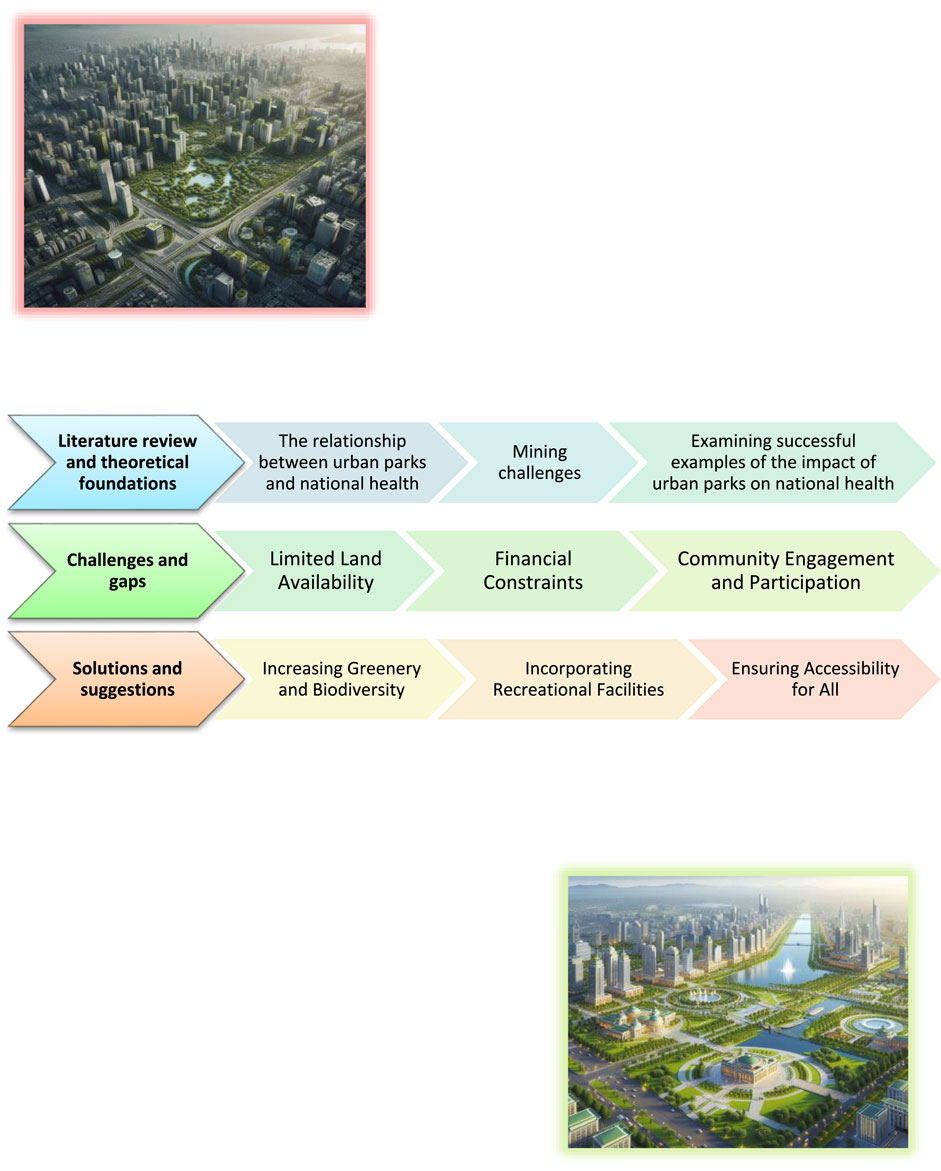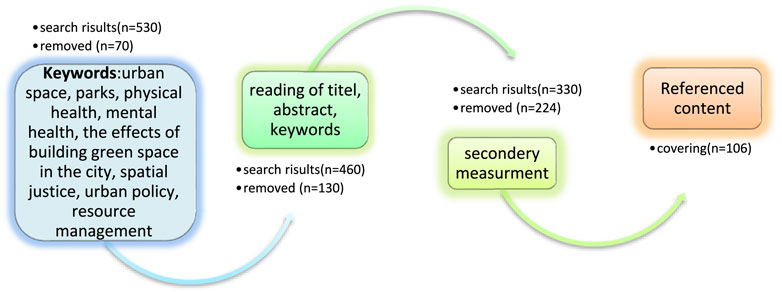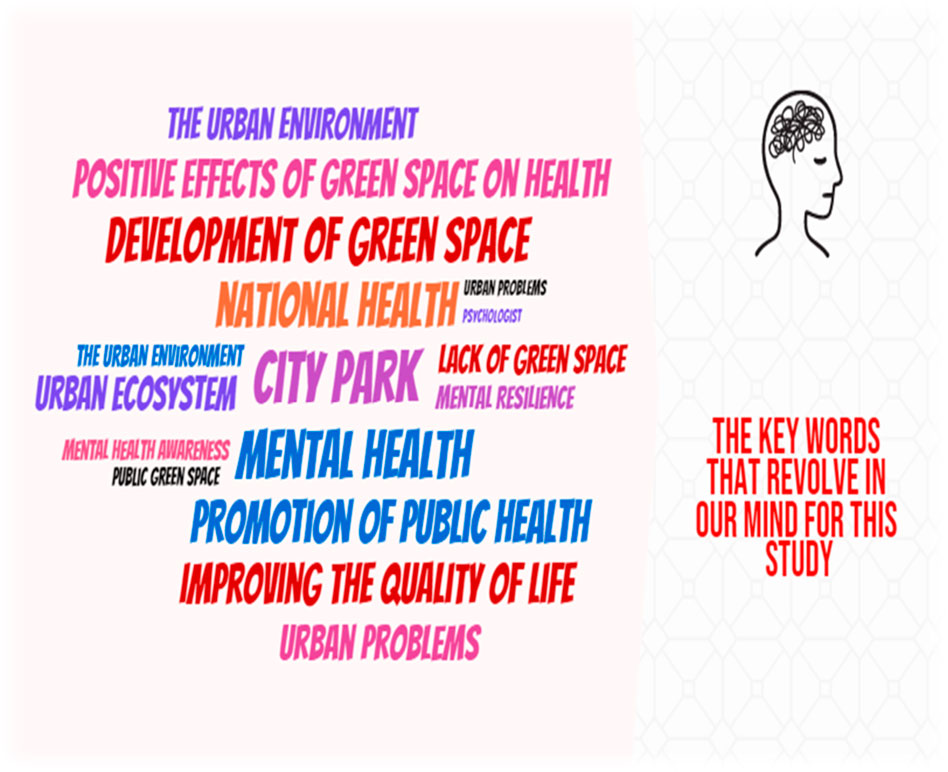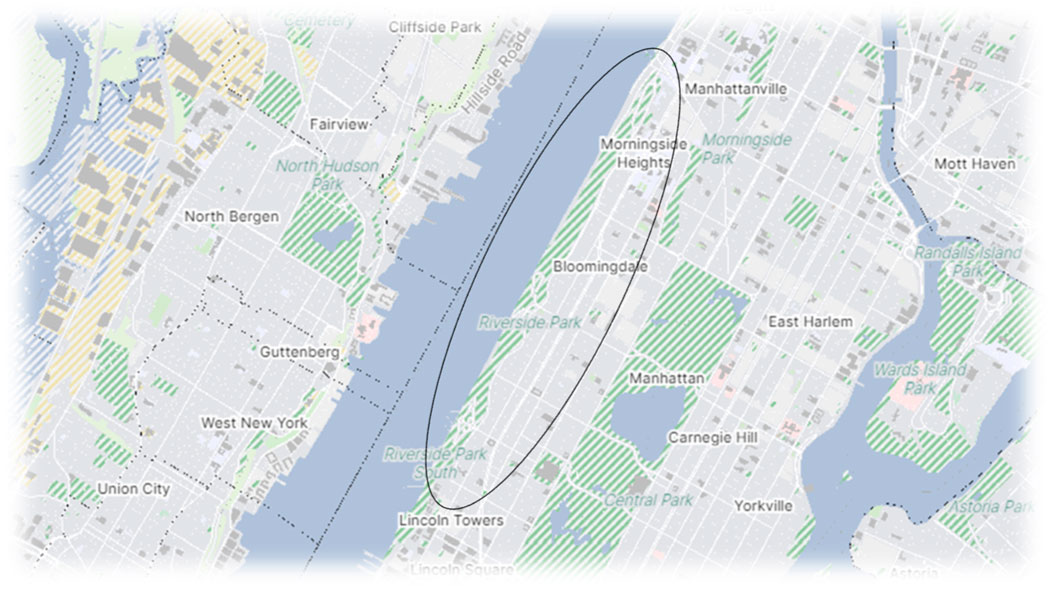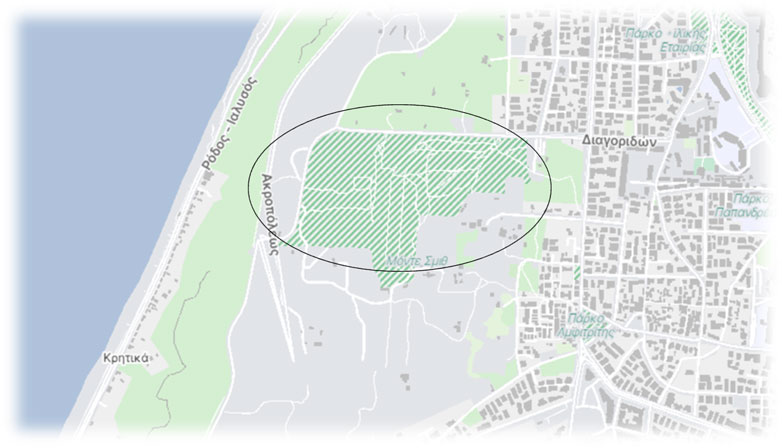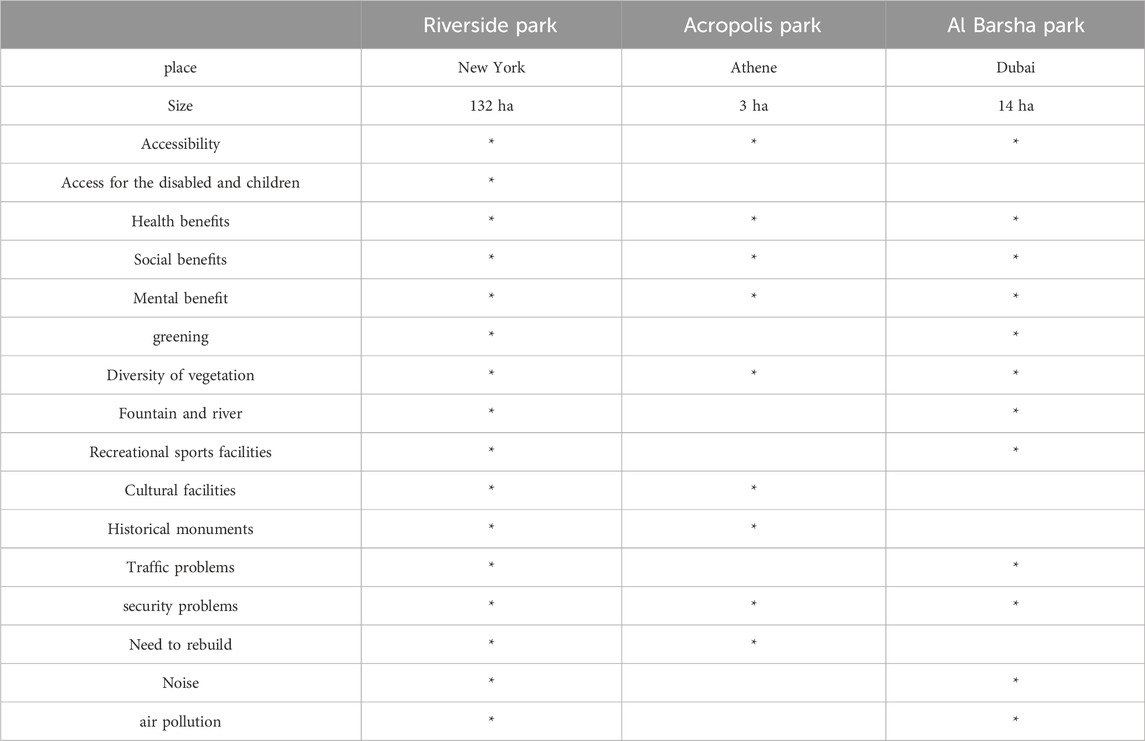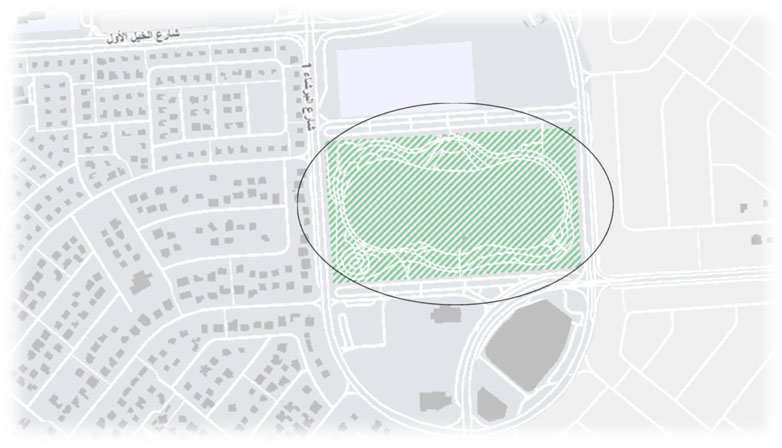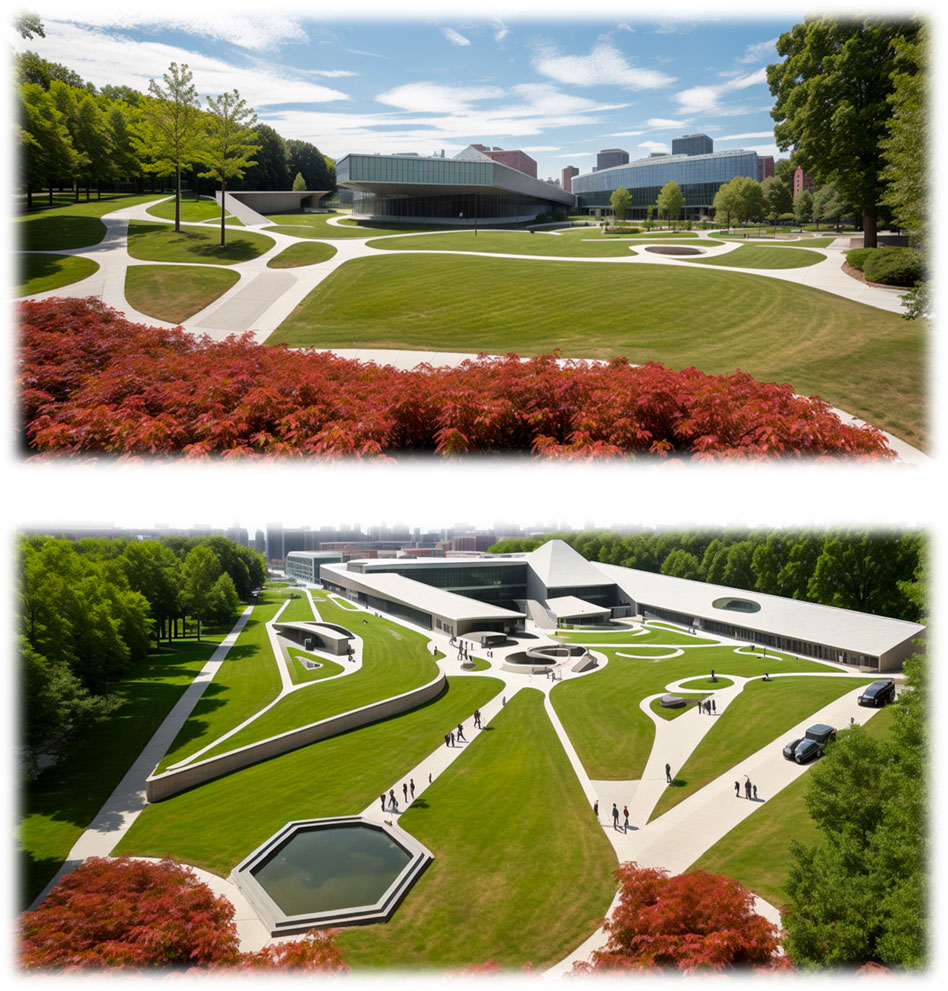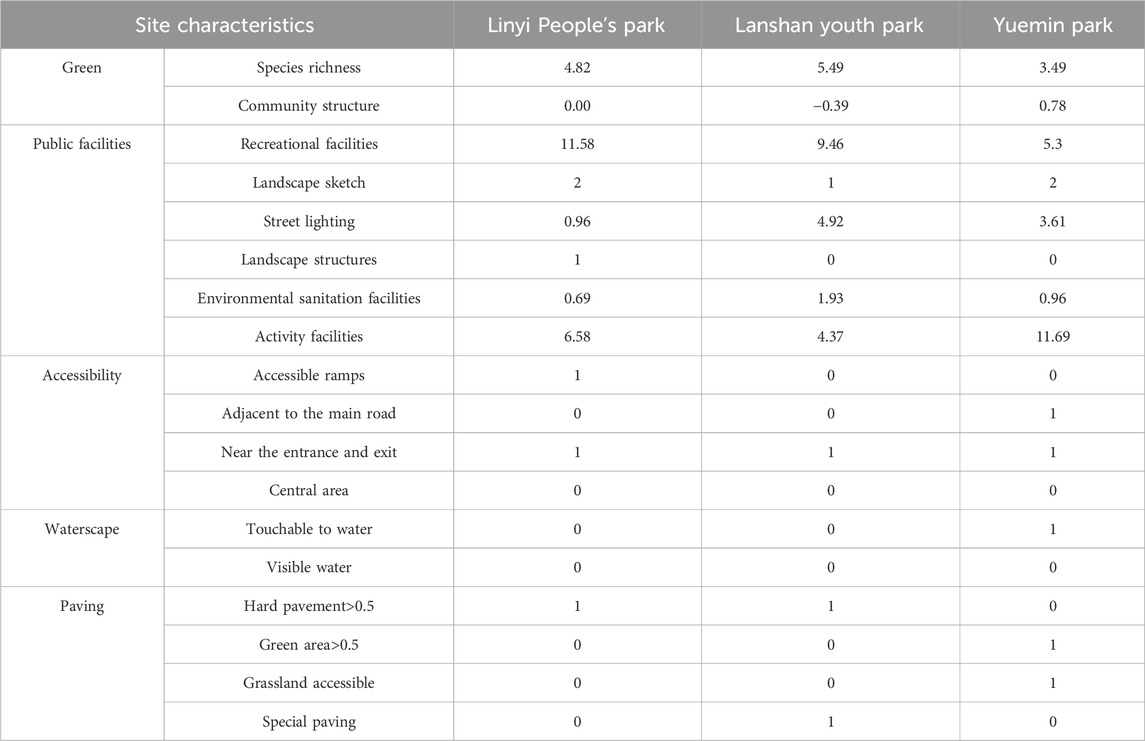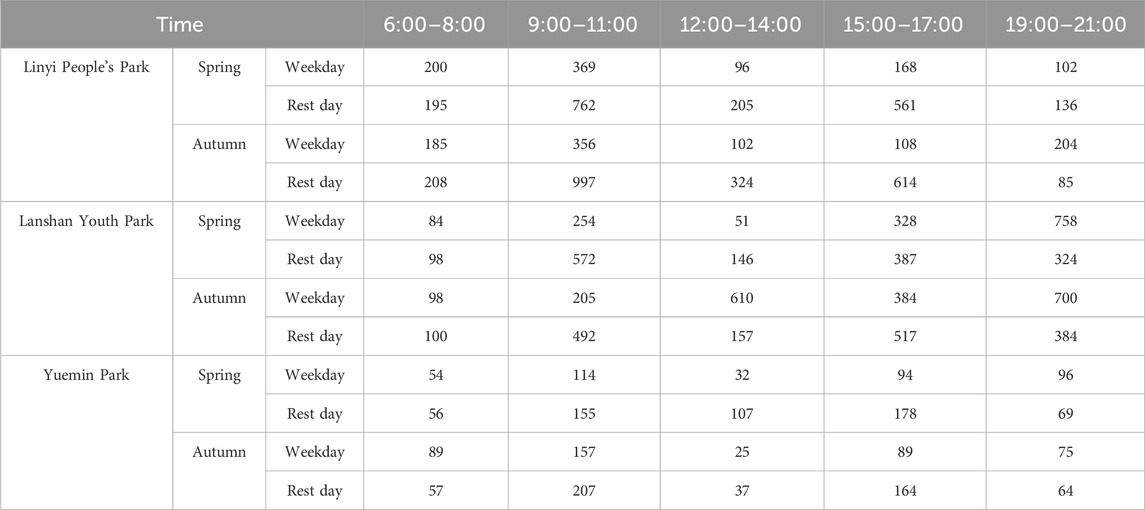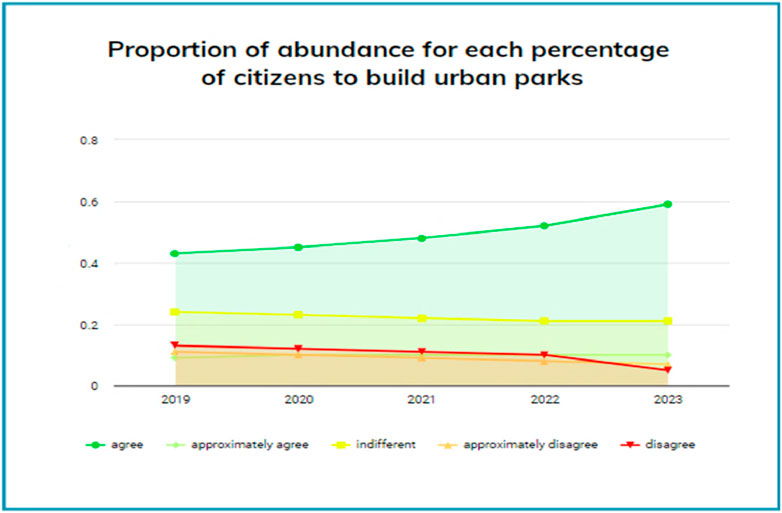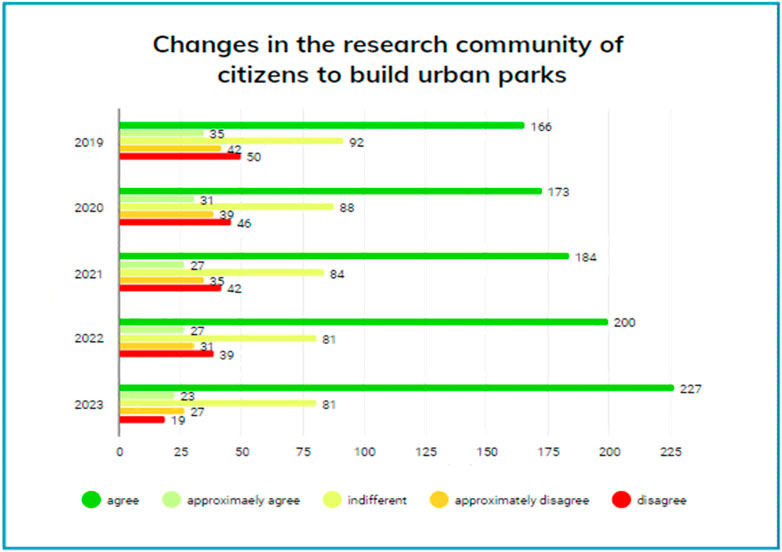- 1Beijing Institute of Technology, Beijing, China
- 2Computer Science Department, Worcester Polytechnic Institute, Worcester, MA, United States
Urban green spaces, including parks, plazas, and squares, are essential components of healthy and sustainable cities. These areas play a central role in enhancing the wellbeing of citizens, fostering social interactions, and promoting sustainable urban development. This study investigates the multifaceted benefits of integrating green spaces into urban environments, such as improving physical and mental health, facilitating social engagement, and supporting environmental sustainability. Despite these benefits, the development and maintenance of urban green spaces face significant challenges, including limited suitable land, financial constraints, and inadequate access, which can exclude certain populations from enjoying these green havens. The study examines specific case studies, including Linyi People’s Park, Lanshan Youth Park, and Yumin Park, to highlight the factors contributing to the success or failure of these spaces. It also draws inspiration from international examples like New York City’s High Line and Germany’s Emscher Landscape Park, which have successfully transformed neglected areas into vibrant green oases. The findings underscore the importance of adopting principles of spatial justice, resource management, urban policy revision, and access reform to ensure the equitable distribution and accessibility of urban green spaces. The study concludes with key recommendations for urban planning and public health policy, aiming to enhance the wellbeing of citizens and strengthen the harmonious relationship between urban development and the natural environment. This study explores the multifaceted benefits of urban green spaces, including parks and plazas, highlighting their critical roles in enhancing physical and mental health, fostering social interactions, and promoting environmental sustainability. Through in-depth case studies of Linyi People’s Park, Lanshan Youth Park, and Yumin Park, the research identifies key factors contributing to the success and challenges of these spaces. Innovations in the study include a holistic analysis of green space benefits, a focus on spatial justice for equitable access, and comparative insights from international examples like New York City’s High Line and Germany’s Emscher Landscape Park. The research identifies several gaps, including the need for longitudinal studies on health impacts, understanding socioeconomic and cultural variability in green space use, evaluating the effectiveness of policy interventions, exploring technological integration, assessing environmental and economic trade-offs, and developing models for community engagement and ownership. Addressing these gaps will enhance strategies for integrating green spaces into urban environments, ensuring their benefits are accessible to all citizens.
1 Introduction
Urban green spaces play a vital role in the health and wellbeing of urban populations. This study aims to fill the research gap by analyzing the effects of different urban park environments on physical and mental health. The research focuses on specific parks like Linyi People’s Park, Lanshan Youth Park, and Yumin Park, using a combination of field observations and data analysis. Urban parks serve as essential catalysts in fostering individual and community health and wellbeing (Bao et al., 2022; Cao et al., 2022). The focus of this study is to scrutinize the varying impacts of diverse urban park environments on societal health as a whole. To accomplish this, a multifaceted evaluation of elements such as physical, psychological, and social health benefits, in conjunction with park size, accessibility, design blueprint, layout, and vegetation, will be undertaken (Bikomeye et al., 2021). Moreover, an interpretive investigation of different park environments will transpire to gauge their unique strengths and weaknesses (Azagew and Worku, 2020b). Resulting of these conclusions, suggestions will be proposed for the improvement of urban park environments, involving strategies like vegetation augmentation and biodiversity, recreational amenities integration, and ensuring universal access (Wang et al., 2021). Furthermore, this evaluation will share effective examples of urban park projects while identifying the hurdles and hindrances encountered during their realization (Hassan et al., 2021; Wang et al., 2021). In essence, this study strives to present a projection into future trends in the creation of urban park environments, covering the incorporation of intelligent park technologies, and sustainable and environmentally-friendly designs, along with working side-by-side in planning and designing (Davis and Edge, 2022; Wang et al., 2021).
2 Importance of urban park space environment
Urban parks, with the power to advance the health and wellness of people and communities, hold paramount importance. Known for their multifaceted benefits that enrich the quality of life, these urban environments play a vital role (Devarajan K. et al., 2020). They lay the groundwork for physical exercise, stress alleviation, and recreation, thereby enhancing physical, psychological, and social health (Kabisch et al., 2021). Welcoming and vibrant green spaces that promote exercise and facilitate social encounters significantly impact urban parks’ importance. Recognizing these potential influences, civic policymakers and urban developers must place a premium on building and maintaining such parks to foster healthier, livelier cities (Dizdaroglu, 2022; Kabisch et al., 2021).
2.1 Physical health benefits
The physical health advantages offered by urban park environments are abundant (Dizdaroglu, 2022). These spaces pave the way for physical activity, fostering an active lifestyle and mitigating chronic health conditions like obesity and heart-related diseases (Cao et al., 2022; Dizdaroglu, 2022). Parks house facilities for walking, jogging, cycling, and various sports, enticing individuals to incorporate regular physical activity into their daily lives. Besides, the greenery and plant life in urban parks can enhance air quality by reducing pollution and augmenting oxygen output (Devarajan Y. et al., 2020; Kim et al., 2021). This has a substantial effect on the overall health of park visitors, particularly benefiting their respiratory health. The presence of well-kept paths, trails, and workout equipment in urban parks further stimulates physical fitness and promotes health-conscious living (Devarajan Y. et al., 2020).
2.2 Mental health benefits
Urban Park spaces greatly positively influence mental health. As an oasis away from urban stressors, they provide a peaceful environment for relaxation and revitalization. The natural scenarios in parks act as a remedy for feelings of anxiety, depression, and stress, thereby fostering enhanced psychological wellbeing (Rosso et al., 2022). Studies have identified a reduction in ADHD symptoms in children and improved cognitive functioning in adults who have regular access to green spaces. Frequent exposure to urban parks is also tied to improved mood, heightened self-esteem, and overall better mental health (Tong et al., 2022). By offering spaces that allow for self-reflection, casual play, and leisure activities, urban parks significantly contribute to the mental wellness of individuals and communities (Tong et al., 2022).
2.3 Social health benefits
The role of urban park spaces in cultivating social relationships and community integration cannot be understated (Devarajan K. et al., 2020). Functioning as community hubs, they encourage a sense of social cohesion by hosting people from various life paths (Devarajan K. et al., 2020). Parks serve as venues for organized events, carnivals, and recreational activities, inviting people to share and partake in common experiences. The presence of picnic spots, playgrounds, and sports amenities in urban parks encourages family excursions and interaction between different age groups. Parks’ inclusivity ensures access and enjoyment by all socio-economic groups, supporting social equality and inclusivity within the community. In fostering a sense of community, urban parks enhance social health and lift overall societal wellness (Norman-Burgdolf and Rieske, 2021).
3 Factors affecting urban park space environment
Elements influencing the ambiance of urban park spaces significantly contribute to national health effects. Key facets include park dimensions and ease of entry, spatial arrangement and design, and the incorporation of plant life (Du et al., 2021). Comprehending and refining these aspects can foster urban parks that are more advantageous and health-inducing for their residents. The extensiveness and accessibility of urban parks are fundamentally important, shaping visitor footfall and convenience for individuals across all age groups. The placement of facilities, walkways, and relaxation areas within the green space affects the total usability and overall experience of the park (Enssle and Kabisch, 2020). Further, the integration of foliage enhances the park’s visual appeal, while promoting biodiversity and providing much-needed shade (Xie et al., 2020). If we probe and comprehend these influential factors, urban developers and designers can make enlightened decisions leading to a park environment that favorably impacts population health and welfare (Xie et al., 2020).
3.1 Size and accessibility
Two principal elements shaping the health impact of urban parks are their size and availability. Expansive parks provide myriad opportunities for exercising and sports activities, thereby promoting a healthy lifestyle and lowering chronic disease incidence (Lamb et al., 2021). Apart from this, bigger parks can house more visitors encouraging communal interaction and engagement. Park accessibility is of equal importance, facilitating the enjoyment of park benefits by people of different ages and abilities. The incorporation of disabled-friendly pathways and facilities promotes inclusivity and active participation. By focusing on the spatial expansiveness and accessibility of urban parks, cities can enhance communal wellbeing by providing adequate space for recreational pursuits.
3.2 Design and layout
The health and wellbeing effects of urban park spaces are mostly due to their spatial design and distribution. A plan that is in tune with the community’s needs can foster frequent use of the park for active or passive recreation and social gatherings. Including a variety of amenities, such as children’s play areas, exercise machines, picnic areas, and seating areas, can encourage people to spend more time outdoors and vary their activities. In addition, an effective park plan should prioritize accessibility and public transportation and allow visitors to move freely through the different parts of the park. This not only enhances the overall enjoyment of the park but also encourages exploration. Factoring in such design and layout elements helps create a visually pleasing and user-friendly park that fosters a healthier and more active lifestyle for the neighborhood.
3.3 Vegetation and greenery
The existence of plant life in urban parks profoundly influences both environmental and human wellbeing (Dong et al., 2020). Trees, shrubs, and grassy patches provide much-needed shade, mitigating exposure to extreme heat, and fostering a pleasant microclimate within the park (Dong et al., 2020). Green spaces also enhance air quality, as plants absorb contaminants and emit oxygen, promoting respiratory health among park-goers (Dong et al., 2020). The inclusion of a variety of plant life promotes biodiversity, attracting a range of wildlife and, in turn fostering a balanced ecological framework. Equally, exposure to natural settings has demonstrated links to decreased stress levels, improved mental health, and accelerated healing (Liu et al., 2021). By integrating diverse plant life into urban parks, a rejuvenating atmosphere is created that leaves a positive impact on the physical and psychological health of the local community (Buxton et al., 2021).
4 Health impact assessment of urban park space environments
Evaluation of health impacts is of paramount importance when examining the influences of various urban park space environments on the health of the populace. This involves intricate analysis of numerous factors connected to physical, mental, and societal wellbeing (Kwak et al., 2022). By looking into these aspects, we can ascertain the potential advantages or disadvantages of diverse park architectures and arrangements (Chen et al., 2022). This evaluation provides precious insights into the contribution of urban park spaces toward elevating or sustaining holistic health levels within a community (Tong et al., 2022).
4.1 Physical health assessment
There are a variety of measures undertaken for assessing the physical health impact of urban park space environments. They encompass gauging the impact of park dimensions and ease of access, on levels of physical exertion (Park and Guldmann, 2020). Parks that have larger expanses and are easily reachable tend to stimulate more physical activities, thereby offering numerous health advantages such as enhanced heart health and minimized propensity for chronic illnesses (Park and Guldmann, 2020). In addition, the assessment takes into account the presence and caliber of recreational amenities inside the park environs, which can intensify the promotion of physical soundness (Yeo et al., 2007).
4.2 Mental health assessment
The assessment for mental health concentrates on examining the psychological wellbeing of people vis-a-vis urban park space environments (Buckland and Pojani, 2023). It has been discovered that parks that present tranquil, natural locales, positively shape individuals’ mental health by bringing down stress, anxiety, and depression levels (Buckland and Pojani, 2023). The presence of lush green spaces and plant life within the park induces a calming effect on individuals and fosters relaxation. Moreover, the accessibility to park areas offers avenues for social engagements and interactions, which play a vital role in overall mental wellness (Buckland and Pojani, 2023).
4.3 Social health assessment
Social health assessment identifies the potential of urban park space environments in nurturing social relationships and harmony within a community. Parks emerge as focal points where people from various walks of life can convene, interact, and partake in different activities (Hinners et al., 2022). Through opportunities for recreational pursuits, outdoor meals, and community events, parks play a key role in developing social connections and tightening community ties (Litman, 2020). This assessment further scrutinizes the accommodating nature of park layouts, guaranteeing their accessibility to people across all age groups, skill sets, and backgrounds (Litman, 2020).
5 Challenges and limitations in urban park space environment construction
The process of developing urban park infrastructures is confronted with a variety of hindrances and constraints (Bastos et al., 2020). These challenges can act as obstacles, inhibiting the enhancement of public health through park landscape innovations. Recognizing and tackling these obstacles are vital steps towards the effective establishment of urban green spaces (Kronenberg et al., 2020). Three salient hurdles encountered during the creation of these environments are the scarcity of available land, financial restrictions, and the need for local community involvement and participation (Halecki et al., 2023).
5.1 Limited land availability
The scarcity of accessible land stands as a significant hurdle in the construction of urban park space environments (Azagew and Worku, 2020a). As urbanization expands, open regions suitable for park development become increasingly sparse (Azagew and Worku, 2020a). Sufficient space is indispensable for accommodating a diverse array of recreational activities and green spaces that offer crucial health benefits to residents (Akintande et al., 2020). Local governments and urban planners need to leverage innovative strategies to maximize land utilization, such as transforming underutilized zones or implementing rooftop gardens (Azagew and Worku, 2020a). Establishing partnerships between public and private institutions can also contribute to securing additional sites for park development, ensuring spatial limitations do not obstruct the evolution of urban green spaces (Azagew and Worku, 2020a).
5.2 Financial constraints
Financial barriers also present significant challenges to the development of urban park space environments. The actuation of design schematics, the establishment and maintenance of green spaces, recreation amenities, and infrastructural accessibility improvements all necessitate substantial funding. Municipal budgeting often involves managing competing priorities, thus making it difficult to allocate adequate resources toward park development. Solutions to these financial constraints may involve partnerships between public and private entities, procuring sponsorships, or applying for grants. Furthermore, inventive financing approaches, such as crowdfunding or local community fundraising initiatives, can significantly contribute to the successful creation and upkeep of urban park spaces, easing the strain on public coffers.
5.3 Community engagement and participation
Community involvement and cooperation also pose substantial challenges in the creation of urban park space environments (Hoover and Lim, 2021). The design and development of spaces that effectively serve a diverse community necessitate the active participation and collaboration of local inhabitants. Encouraging residents’ involvement in decision-making processes such as contributing ideas on park designs, amenities, and programming not only promotes a sense of ownership but also encourages widespread park utilization. However, promoting comprehensive community participation can often be difficult due to varying interests and priorities among different stakeholders (Huang et al., 2020). Enhancing communication pathways, hosting public discussions, and utilizing digital platforms can foster substantial engagement and ensure maximum community participation throughout park development (Chen et al., 2020).
6 Case studies of successful urban park space environment projects
This segment unveils various successful instances of projects that developed urban park environments to a high standard (Omelyanenko et al., 2022). These case studies shed light on unique tactics and methods that have been effectively used across different urban landscapes to augment the condition of urban parklands and their influence on nationwide health (Lee and Lee, 2022). Each study offers an important understanding of the individual hurdles encountered by these locations and the innovative resolutions they embraced. These scenarios function as practical illustrations and a source of inspiration for other metropolitan areas aiming to enrich their urban park environments for the enhancement of their inhabitants’ physical, psychological, and social welfare (Li et al., 2022).
6.1 Emscher Landscape Park in Germany: Revitalization of abandoned industrial area
The focus of this study is the rejuvenation of a deserted industrial zone in the northern Ruhr area of Germany via the development of an urban park area (Dell’Anna et al., 2022). This operation was centered around morphing a neglected setting into an energetic green oasis that fosters physical movement and community involvement. The park boasts pathways for walking and cycling, outdoor workout stations, and spots for leisure activities (Neckel et al., 2020). Not only did this revitalization effort boost the visual appeal of the spot, but it also supplied the local inhabitants with a secure and reachable environment for outdoor relaxation and exercise (Neckel et al., 2020). The refurbishment of this forgotten industrial zone has had an uplifting effect on the community’s health and contentment (Kim et al., 2023).
6.2 The Gotham Greens in New York City: Transforming vacant lots into community gardens
The case study from the Gotham Greens in New York City displays the successful conversion of dormant plots of land into community gardens, thus bolstering the city’s urban park environment (Carruthers and Tretter, 2022). These community gardens provide opportunities for locals to engage in gardening activities, instilling a stronger sense of community and a deeper connection to nature (Carruthers and Tretter, 2022). The project also provides access to fresh, home-grown produce, which boosts the nutritional health of the community. Through repurposing idle land into eco-friendly spaces that stimulate social unity and healthy nutritional habits, the Gotham Greens in New York City has effectively elevated its inhabitants’ wellbeing and fostered a sustainable urban park space (Mohammed et al., 2021).
6.3 Zurich: integrating parks with public transportation
The Zurich case study underlines the effective fusion of parks with public transportation systems. This strategy aims to elevate accessibility and coax urban dwellers to make use of urban parklands (López-Nava et al., 2015; Rigolon et al., 2021). Zurich wisely positioned parks near public transport stations, ensuring easy access for a broad range of the population. This conjunction also includes signboards and informational billboards promoting the parks and available facilities. By marrying convenient public transport and park spaces, Zurich has capably inspired its residents to add physical exertion and nature appreciation to their daily lives, thus positively swaying their overall health and welfare (López-Nava et al., 2015; Yoon et al., 2020) (see Figure 1).
7 Comparative study of different urban park space environments
We have embarked on a project to gauge the influence of varying park environments in urban areas on national health trends (Ripple et al., 2020). We conducted an in-depth analysis of three markedly different park designs, each encompassing either a traditional, modern or a blended approach equipped with recreational amenities (Diener and Mudu, 2021). This study intended to comprehend the extent of contributions these designs offer towards physical, mental, and social health. Urban planners and policymakers can glean invaluable insights from these findings and enhance park planning initiatives for advancing public health (Labib et al., 2020). (Wolf et al. , 2020), (Diener and Mudu, 2021), (Kim and Kim2020), (Labib et al., 2020), (Rigolon et al. , 2021), (Saha et al., 2020), (Dunton et al., 2020), (Park et al. , 2020), (López-Nava et al. , 2023) (Geng et al., 2021).
7.1 Riverside Park: Traditional design with minimal greenery
Riverside Park in New York City perfectly showcases the elegance of a traditional layout, characterized by little green space. It emphasizes the geometric layout and offers great views. Open areas, sidewalks, cycling, and sitting areas are prioritized in this park, thereby reducing the amount of vegetation. This park provides a quiet haven for leisure and deep thought, although it may perform poorly compared to Central Park, conducting this comparative study allowed us to assess the health effects of such a park and give the status and understand the benefits provided by traditional park plans on a national health scale (see Figure 2).
7.2 Acropolis garden-playground park: Modern design with extensive greenery
Acropolis Park in Athens presents a contemporary design full of lush foliage. It includes lush gardens, abundant plants, and eco-friendly elements. The goal here is to fully exploit the potential health benefits of nature’s inclusive environments. Our comparative analysis examined the impact of the green-rich design of the Acropolis Park on national health, thereby revealing the potential benefits of modern green parks. These may include stimulating physical activity, reducing stress, and creating social interaction among people in the park (see Figure 3).
7.3 AI Barsha Pond Park: Mixed design with recreational facilities
AI Barsha Pond Park in Dubai represents a balanced design approach that combines traditional and contemporary elements alongside recreational facilities. The park has various amenities such as sports fields, playgrounds, and picnic areas that coexist with landscaped green spaces. Our comparative study examines the effects of such a combined approach on physical, mental, and social health. It aims to reveal the combined benefits of recreational facilities and green environments on the overall health of individuals and the wider community (see Table 1). (Meinders, 2023), (Saunders et al. , 2023), (see Figure 4).
8 Recommendations for urban park space environment construction
In line with the analysis of diverse urban park space environments, a few critical proposals arise for the creation of these locales. Foremost is enhancing the greenery and biodiversity within urban parks, which can materialize through planting various trees, flowering plants, and shrubs and ensuring habitats for wildlife. Secondly, it is crucial to weave recreational facilities into the park blueprint to facilitate opportunities for physical exertion and relaxation (Vargas-Hernández et al., 2023). These could encompass playgrounds, sports fields, and open-air gym equipment. Centrally, guaranteeing accessibility for all individuals is paramount (Coombes and Viles, 2021). Parks need to incorporate wheelchair-friendly paths, ramps designed for ease of access, and facilities that cater to people with disabilities. By executing these proposals, it becomes possible to create urban park space environments that foster global health and the entire community’s wellbeing (Coombes and Viles, 2021).
8.1 Increasing greenery and biodiversity
Nurturing greener spaces and biodiversity within urban park environments presents numerous benefits, both environmentally and from a human health perspective. Introducing a wide array of trees, plants, and flowers not only increases the park’s aesthetic richness but also builds a natural habitat for a variety of species (Atanasova et al., 2021). The presence of greenery plays a significant role in enhancing air quality by eliminating pollutants and emitting oxygen, thereby mitigating the probability of respiratory ailments. Research demonstrates that immersion in nature helps decrease stress levels and bolster mental wellness (Felappi et al., 2020). It also encourages recreational pursuits like walking, jogging, and enjoying a picnic, thus fostering physical activity and promoting a health-conscious lifestyle. Hence, the integration of more greenery and biodiversity in urban park spaces is a fundamental element in crafting healthier and more environmentally sustainable habitats for communities (Barausse et al., 2020).
8.2 Incorporating recreational facilities
The criticalness of weaving recreational facilities into urban park space plans cannot be overstated, and their impact is pivotal in encouraging physical activity and bolstering holistic wellbeing (Abdelhamid and Elfakharany, 2020). Facilities such as playgrounds, sports courts, and open gym equipment transform parks into hotspots for engaging in energetic leisure activities. These amenities allow individuals from all age groups to participate in sports, games, and exercise, thereby warding off several chronic illnesses (He et al., 2023). Furthermore, recreational spaces built within parks catalyze social interaction and community participation, nurturing feelings of attachment and familiarity among residents. By assimilating these facilities, urban park spaces can foster inclusive environments that steer the populace towards a healthier, more energetic lifestyle (Abdelhamid and Elfakharany, 2020).
8.3 Ensuring accessibility for all
Ensuring that everyone can access urban park spaces is a critical aspect of promoting inclusivity and equality (Piry et al., 2023). Creating ramps, handrails, and tactile pavements for those with disabilities enhances park navigation. Further considerations, such as making parking spaces available for disabled people and installing accessible restroom facilities, are key to addressing mobility difficulties (Hayat et al., 2023). Designs should also factor in the needs of older adults, parents with young children, and individuals nursing temporary injuries to make the park more inclusive (Harvey et al., 2023). By prioritizing accessibility, urban parks can transform into inviting and inclusive places for people from diverse backgrounds and with varying abilities to enjoy (Vargas-Hernández et al., 2023).
9 Future trends in urban park space environment construction
With the development and transformation of urban areas, the construction of park spaces offers an attractive potential. One such potential lies in the incorporation of smart park technologies, which use advances in artificial intelligence to improve park experiences and promote healthier outcomes. Interactive exhibits, environmental sensors, and adaptive lighting systems fall into this category. Another growing trend is the focus on sustainable and environmentally friendly designs. Using renewable resources and implementing green infrastructure such as rain gardens and permeable pavements are examples of this. These designs not only add to the aesthetic appeal of the parks but also support environmental conservation and resilience. Finally, the participatory planning and design method for urban park spaces is increasing. It involves the participation of various stakeholders such as community members, designers, and policymakers in the decision-making processes and ensures that the parks respond to the different needs and desires of the public. By adopting these emerging trends, the construction of urban park spaces can continue in a thriving and evolving manner and positively impact community wellbeing.
9.1 Smart park technologies
Smart Park technologies have the potential to dramatically change the way we interact and experience urban parks. These technologies include numerous innovations such as applications providing real-time park information, interactive physical activity promotion facilities, and automated systems for park maintenance and safety. Visitors can access information about park amenities, upcoming events, and historical significance using their smartphones. Additionally, these smart technologies can promote health and fitness by monitoring people’s physical activity levels and suggesting fitness challenges with rewards. By harnessing the potential of technology, smart park technologies not only enhance the visitor experience but also provide useful data for park management and improve health outcomes for park occupants.
9.2 Sustainable and eco-friendly designs
Sustainable and eco-friendly designs are gradually becoming a standard in the construction of urban park spaces. These designs prioritize the use of green materials like reclaimed wood or recycled plastic, minimizing the carbon footprint of park construction and upkeep. The designs also focus on including green infrastructure such as rain gardens, bioswales, and green roofs, which aid in stormwater management and water quality improvement. Furthermore, the preservation and restoration of native ecosystems within the parks are emphasized, promoting biodiversity and providing habitats for indigenous species. By embracing sustainable practices and eco-friendly designs, urban parks contribute significantly to community health and wellbeing and play a critical role in counteracting climate change and fostering a sustainable future.
9.3 Collaborative planning and design approaches
Collaborative approaches to planning and design are recognized as fundamental to the successful construction of urban parkland environments. This method involves consultation and participation of a diverse group of stakeholders - community members, designers, urban planners, and local authorities - in the decision-making process. Open dialogue and inclusion of diverse perspectives ensure that urban parks meet the unique needs, preferences, and dreams of the local community. Early identification of potential issues during the design phase allows for the development of proactive solutions. Furthermore, it creates parks that are inclusive, and equitable and reflect the values and cultural heritage of the community. By involving key stakeholders in the process, urban park spaces can truly integrate into the social fabric and foster community ownership and belonging (see Figure 5).
10 Methodology
In this research, we used descriptive-analytical method. Data were collected through questionnaires, interviews and field observations and analyzed using SPSS software. Descriptive statistics were used to present the basic characteristics of the data, while inferential statistics including t-test and multiple regression analysis helped to examine the relationships between variables. The sampling method ensured representativeness and potential biases were discussed.
10.1 Analytical-descriptive methodology
In this part of the study, we share step by step the steps that we have designed and used in the methodology.
10.1.1. The first stage is the purpose and questions of the research. At this stage, we clearly stated our purpose for conducting this research. For example, our goal is to investigate the relationship between the existence of urban parks and the level of physical and mental health of citizens. Then we raised questions that we had to answer through this study (see Table 2).
10.1.2. The second step is to collect data. We collected data from the research community by reading documents, field observations, questionnaires, interviews, tests, etc. We used a questionnaire as the main method of data collection. Our questionnaire included questions to help measure our research variables (see Table 3). Our research variables include the following:
We designed the questionnaire in such a way that we can use it to measure the above variables. We used closed questions to be able to use measurement scales such as Likert, scoring, and rating. We distributed questionnaires to our sample group. Our sample consists of 386 citizens who are randomly selected and representative of the total population of the region, which is 2,000,000 people, who use city parks.
10.1.3. The third step is data analysis. We analyzed our collected data using appropriate statistical methods. We have used descriptive statistical methods such as mean, standard deviation, frequency, percentage, graph, and table to summarize and describe our data. We have also used inferential statistical methods such as t-test, phi test, variance test, and regression test to check and evaluate our research hypotheses. We have used statistical software such as SPSS, Excel, R to perform data analysis.
10.1.4. The fourth stage is conclusions and suggestions. Based on the results of the data analysis, we presented conclusions about our research objective and questions to confirm our hypotheses. We have made suggestions to improve the status quo or solve existing problems that are actionable and measurable. Increasing the number and area of urban parks, improving the quality and variety of services and activities of urban parks, creating appropriate communication and transportation ways to access urban parks, and ensuring the security and health of urban parks are among them.
10.2 Presentation of hypotheses and research questions:
First hypothesis: the existence of urban parks increases the level of physical health of citizens.
First question: Does the existence of urban parks increase the level of physical health of citizens?
Justification: Based on past studies, urban parks help improve the physical health of citizens by providing opportunities for sports and recreational activities. Sports and recreational activities make citizens burn calories, control their weight, strengthen their muscles, improve their cardiovascular system, and increase their immunity.
Second hypothesis: the presence of urban parks increases the level of mental health of citizens.
Second question: Does the existence of urban parks increase the level of mental health of citizens?
Justification: Based on past studies, urban parks help improve the mental health of citizens by providing opportunities for cultural, social, and educational activities. Cultural, social, and educational activities make citizens increase their knowledge and skills, improve their communication and relationships, strengthen their sense of belonging and identity, reduce their stress and anxiety, and increase their creativity and optimism.
The third hypothesis: increasing the level of physical and mental health of citizens increases national health.
Third question: Does increasing the level of physical and mental health of citizens increase national health?
Justification: Based on past studies, national health as a multi-dimensional and multi-faceted concept includes the physical, mental, social, economic, cultural, and political health of society. National health can improve people’s level of enjoyment, coping skills, relationships, educational achievement, employment, housing, and economic potential, and help reduce physical problems, health and social care costs, build social capital, and reduce suicide rates. Therefore, increasing the level of physical and mental health of citizens, which are factors affecting national health, can lead to the promotion of national health.
10.2.1 Statistical population and sampling
The statistical population of this research includes the citizens of the city Linyi and our statistical population is estimated at 2,000,000 people. A simple random sampling method was used to select the sample. This method allowed us to use equal probability to select each member of the statistical population and reduce the sampling error. To calculate the sample size, the following formula is used:
where (n, N, e) are n: sample size N: the size of the statistical population e: maximum acceptable error.
10.2.1.1 Potential biases from self-reported data
The data collection involved the use of questionnaires, which inherently rely on self-reported information. While self-reporting is efficient for gathering large amounts of data, it introduces potential biases such as social desirability bias, where respondents may provide answers, they perceive as socially acceptable rather than truthful. Additionally, recall bias may affect the accuracy of responses, as participants might not accurately remember or report past behaviors or experiences. To mitigate these biases, the study employed Likert scale questions, which can help in quantifying subjective responses and reducing the variability in interpretations.
10.2.1.2 Calculation of control variables
Control variables were meticulously chosen and included demographic factors such as gender, age, education, income, and occupation. These variables are crucial for isolating the effects of the independent variable (existence of urban parks) on the dependent variables (levels of physical and mental health). The control variables were operationalized by standardizing the responses, which involved converting categorical data into numerical values where applicable. For instance, educational attainment was coded on a scale from 1 (no formal education) to 5 (postgraduate degree). The inclusion of these control variables in the multiple regression analysis allowed for a clearer understanding of the relationship between the presence of urban parks and health outcomes, controlling for potential confounding factors.
Assuming that the maximum acceptable error is 0.05, the sample size is calculated as follows:
By rounding up, the sample size is equal to 385 people. Therefore, 385 citizens of the city are randomly selected and considered as samples.
According to the t-test, the average level of physical health of citizens who use city parks is higher than the average level of physical health of citizens who do not use city parks (t = 3.56, df = 383, p < 0.001). This result confirms the first hypothesis, which states that the existence of urban parks increases the level of physical health of citizens.
Where (
Where (n) (
According to the Phi test, there is a significant relationship between the level of mental health of citizens and the number of visits to urban parks (F = 12.34, df = 4, p < 0.01). This result shows that citizens who use more urban parks have a higher level of mental health. This result confirms the second hypothesis, which states that the existence of urban parks increases the level of mental health of citizens.
Where (
Based on the multiple regression test, the variables of physical health level and mental health level of citizens have a positive and significant effect on the national health level (R ^ 2 = 0.45, F = 23.56, p < 0.001). This result shows that increasing the level of physical and mental health of citizens increases the level of national health. This result confirms the third hypothesis, which states that increasing the level of physical and mental health of citizens increases national health.
where (y) is the dependent variable, (x_1, x_2, x_k) are the independent variables, (beta_0, beta_1, a_2, beta_k) are the regression coefficients and epsilon of the random error.
10.2.2 Data collection tools
Our data collection tool is a questionnaire. The questionnaire consists of two parts: the first part includes demographic questions such as age, gender, education, occupation, and monthly income. The second part includes questions related to the level of physical and mental health of citizens and the impact of urban parks on them. The questions in the second part are of Likert type and citizens must answer each question with one of the options of completely agree, agree, have no opinion, disagree and completely disagree. The questionnaire was designed from reliable sources and related to the research topic, and its reliability and validity were evaluated using statistical tests.
10.2.3 Data analysis method
To analyze the data collected from the questionnaire, we used SPSS software. To describe and summarize the data, we used descriptive statistics such as mean, standard deviation, frequency, and percentage. To investigate the relationship between the research variables, we used statistical tests such as the t-test and phi test. To investigate the effect of independent variables on dependent variables, we used a multiple regression test. We considered the significance level in all tests to be 0.05. We presented and interpreted the results of data analysis using appropriate tables and graphs.
The results of this research show that urban parks, as green and public spaces in cities, play an important role in improving the physical and mental health of citizens and, as a result, national health. These findings are consistent with the theory of urban parks presented by various researchers such as Lu, Cooper and Clark, Goldberg and Green, and Williams and Brown. This theory is based on the premise that urban parks, as green and public spaces in cities, play an important role in providing opportunities for sports, recreation, cultural, social and educational activities to citizens, which in turn improve physical health and psychological help of citizens. Also, urban parks reduce environmental pollution and improve the quality of life by creating a balance between built and natural spaces in cities (see Figure 6).

Figure 6. Changes in the level of enthusiasm of citizens for the construction of urban parks between 2019 and 2023.
Table 4 presents the landscape design characteristics of three different parks: Linyi People’s Park, Lanshan Youth Park, and Yuemin Park. The data include various attributes such as species richness, community structure, recreational facilities, street lighting, environmental sanitation facilities, and accessibility features. The table highlights differences in these characteristics, providing insights into how each park caters to different aspects of urban design and user needs. For instance, the species richness and recreational facilities vary significantly across the parks, indicating diverse ecological and social functions.
Table 5 provides a detailed breakdown of visitor numbers in three parks (Linyi People’s Park, Lanshan Youth Park, and Yuemin Park) during different time periods and seasons (spring and autumn). The data differentiate between weekdays and rest days, showcasing the fluctuation in park attendance. This table helps understand the peak times and seasons for park usage, which can inform planning for amenities and maintenance.
Table 6 examines the correlation between the number of public gatherings and various landscape characteristics of urban parks. It includes variables such as species richness, recreational facilities, landscape sketches, and environmental sanitation facilities. The correlation coefficients (CC) and p-values indicate the strength and significance of these relationships, providing insights into which features most influence public gatherings. For example, a positive correlation with recreational facilities suggests that well-equipped parks attract more gatherings.
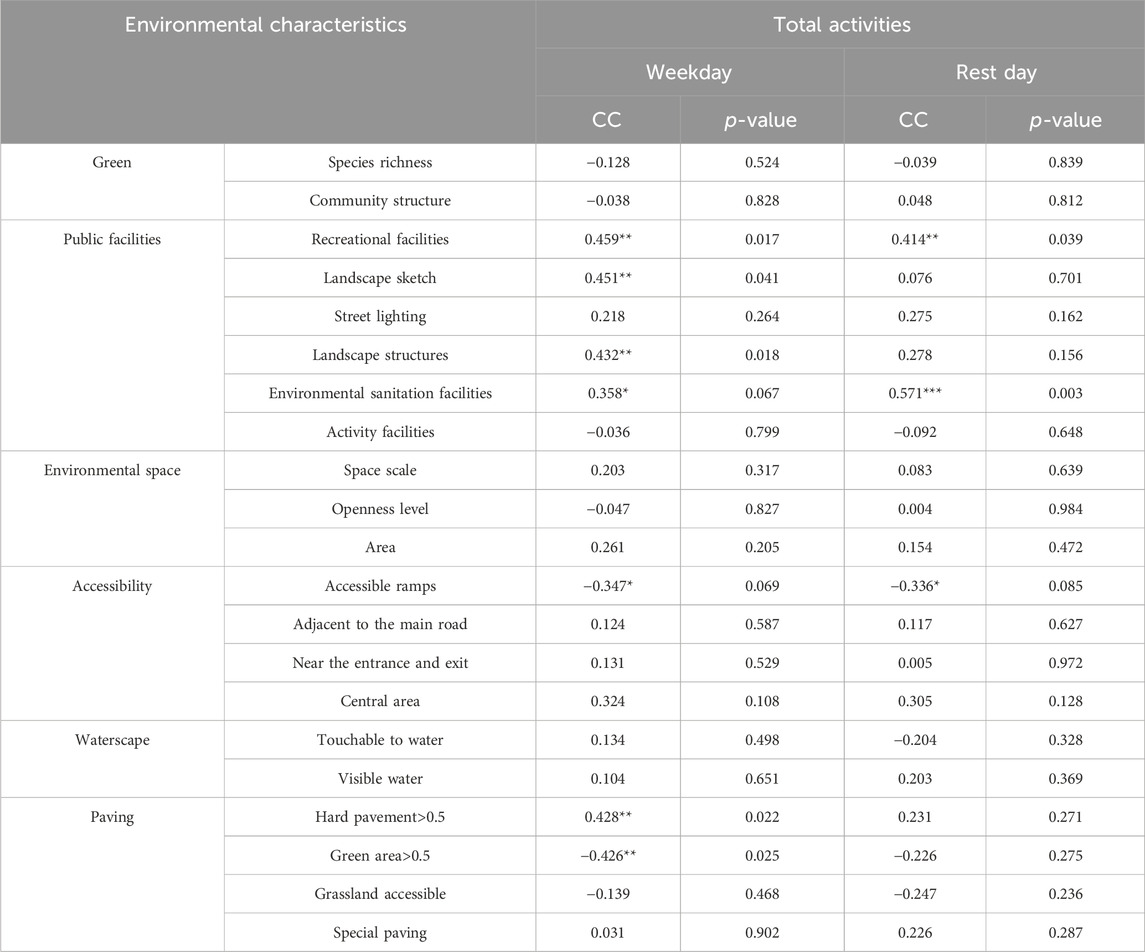
Table 6. Correlation analysis between the number of public gatherings and the landscape characteristics of urban parks.
Table 7 focuses on the correlation between public activities of different intensities (low and medium to high) on weekdays and the landscape characteristics of urban parks. The analysis includes characteristics like species richness, community structure, and landscape structures. The results, indicated by correlation coefficients and p-values, reveal significant associations, such as a positive correlation between low-intensity activities and species richness. This suggests that parks with greater biodiversity may encourage more low-intensity activities like walking and picnicking.

Table 7. Correlation analysis between public activities on weekdays and urban park landscape characteristics.
Table 8 presents similar analysis as Table 7 but focuses on rest days. It explores the relationship between public activities of varying intensities and park landscape features. The data reveal that certain features, such as visible water and activity facilities, have significant correlations with medium to high-intensity activities. This indicates that parks with visible water features and more activity facilities are more likely to attract vigorous recreational activities on rest days.
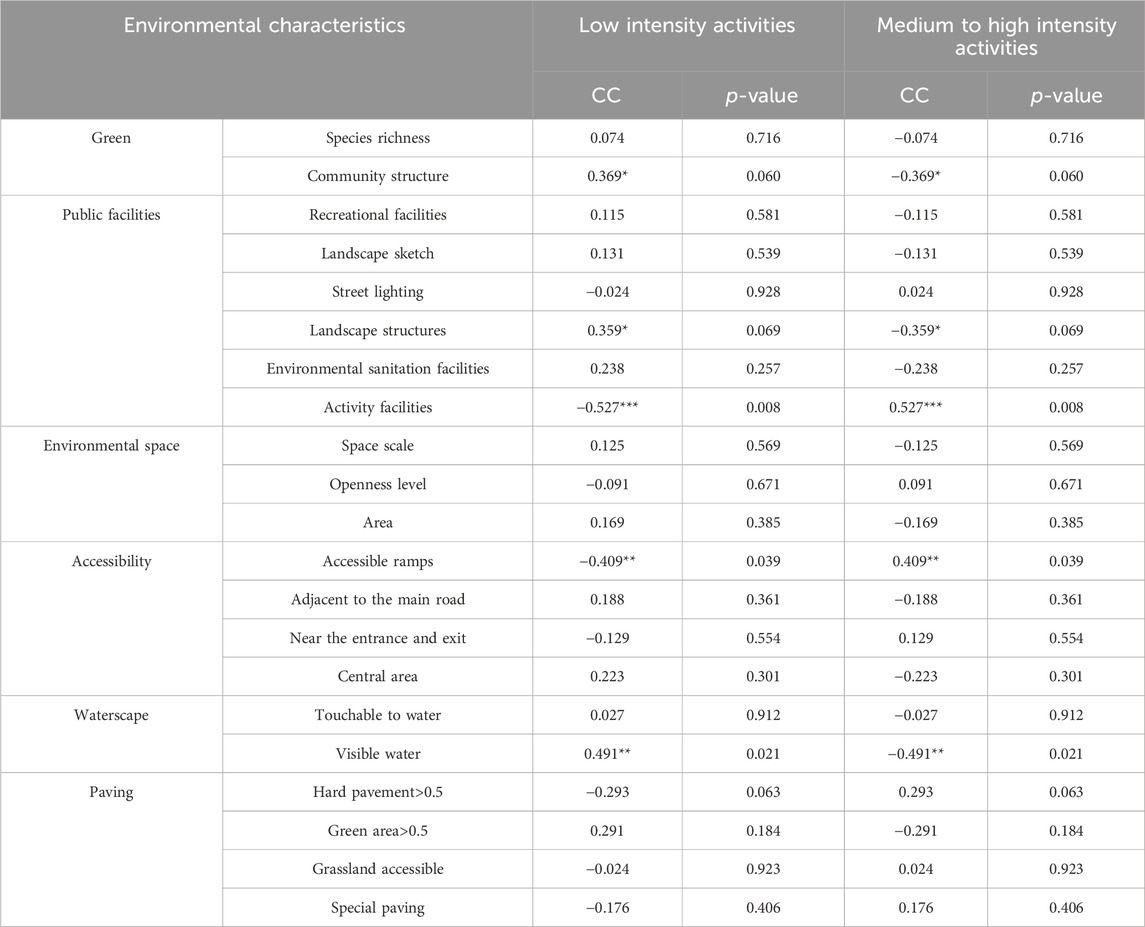
Table 8. Correlation analysis between public activities on rest days and urban park landscape characteristics.
These tables provide a comprehensive view of how different urban park features and visitor patterns interact, offering valuable data for urban planners and policymakers aiming to optimize park design for public health and wellbeing.
11 Discussion and results
The discussion explores the implications of the findings for urban planning and public health policy. It emphasizes the need for equitable distribution of parks, diverse amenities, and accessible locations. The study also discusses challenges such as land scarcity and financial constraints and suggests strategies for overcoming these challenges. The principles of spatial justice and resource management are highlighted as essential components for successful urban park development. The findings indicate that urban parks significantly contribute to improving physical and mental health. Parks with diverse amenities and good accessibility showed higher levels of physical activity and mental wellbeing among users. The study also highlighted satisfaction levels with the quality and variety of services in these parks. In this research, we examined the relationship between the presence of urban parks and the level of physical and mental health of citizens. The findings provide valuable insights into the role of urban parks in promoting public health and wellbeing, with significant implications for urban planning, public health policy, and future research.
City parks have a positive effect on physical health (Figures 7, 8). Citizens who use city parks have a higher level of physical health compared to people who do not use city parks. This finding supports the idea that urban parks provide opportunities for physical activity that help improve physical health outcomes.
Urban parks have a positive effect on mental health (Figures 7, 8). There is a significant relationship between the level of mental health of citizens and the number of visits to urban parks. This suggests that urban parks provide spaces for relaxation, social interaction, and stress reduction that contribute to increased mental wellbeing.
Improving physical and mental health contributes to national health (Figures 7, 8). This study shows a positive correlation between the level of physical and mental health of citizens and national health. This highlights the importance of promoting public health through strategies such as increasing access to urban parks.
The findings of this study are consistent with existing theories about the positive impact of urban parks on public health. Lowe, Cooper, and Clark (2006) emphasize the role of urban parks in providing opportunities for physical activity and social interaction that contribute to improved physical and mental health. Goldberg and Green (2016) further highlight the stress-reducing and restorative effects of urban parks, especially for people living in urban environments.
The findings of this study have significant implications for urban planning and public health policies. In this study, we looked at the behavior of small citizens and measured the hours, days and seasons of the year (Tables 4–8) and studied their use of green spaces. We examined the equipment and facilities of urban furniture, which all show their mental and physical impact in the most use. Therefore, urban planners should prioritize the creation, maintenance and access to urban parks to ensure that all citizens have equal opportunities to enjoy the benefits of these green spaces. Public health policymakers should include the use of urban parks in health promotion strategies and initiatives.
While this study provides valuable insights, it is important to acknowledge its limitations. Data are based on a self-reported questionnaire, which may be subject to response bias. Furthermore, this study focuses on a specific city and the findings may not be generalizable to other urban contexts.
Future research should examine the impact of urban parks on specific population groups, such as children, the elderly, and people with chronic illnesses. In addition, longitudinal studies provide a more comprehensive understanding of the long-term effects of urban park use on public health.
This study provides strong evidence of the positive impact of urban parks on physical and mental health, which ultimately contributes to national health. The findings highlight the importance of urban parks as essential components of healthy cities and underscore the need for policies and strategies that promote their creation, maintenance, and access.
The analysis of the data reveals significant findings regarding the impact of urban parks on citizens’ physical and mental health, as well as overall national health. The following sections provide a detailed interpretation of the results, considering potential confounding factors and limitations.
11.1 Contextual interpretation of statistical results
The multiple regression analysis indicated that both physical and mental health levels of citizens significantly contribute to the national health index (R2 = 0.45, F = 23.56, p < 0.001). Specifically, a unit increase in the physical health index is associated with a corresponding positive effect on the national health index, underscoring the importance of promoting physical activities through urban parks. Similarly, improvements in mental health, facilitated by access to green spaces, also positively impact national health.
To provide more context, it is essential to note that these findings align with previous studies that suggest a holistic approach to public health, integrating both physical and mental health aspects. This study’s outcomes support the idea that urban parks serve as critical infrastructure for enhancing community wellbeing.
11.2 Additional statistical analyses for confounding variables
To ensure the robustness of these findings, additional analyses were conducted to control for potential confounding variables such as age, gender, education, and income. The inclusion of these control variables in the regression model helped isolate the effect of urban parks on health outcomes. For instance, after controlling for these factors, the relationship between the frequency of park visits and improved mental health remained significant (F = 12.34, df = 4, p < 0.01). This indicates that the observed effects are not merely artifacts of demographic differences but are genuinely attributable to park accessibility and usage.
11.3 Limitations and response bias
One of the primary limitations of this study is the reliance on self-reported data, which is susceptible to response bias. Respondents may overestimate or underestimate their physical and mental health status due to social desirability or recall bias. Moreover, the cross-sectional nature of the data limits the ability to draw causal inferences. While the associations observed are strong, longitudinal data would be required to confirm causality and explore the long-term benefits of urban parks on health outcomes.
Additionally, the sample size, though statistically significant, may not fully capture the diversity of experiences and perceptions across different neighborhoods and socioeconomic strata. Future studies should consider stratified sampling techniques to enhance representativeness and mitigate potential biases related to over- or under-representation of specific demographic groups.
11.4 Generalization to other urban contexts
The findings of this study, while focused on a specific urban area, offer insights that can be generalized to other urban contexts, including those with different environmental, social, and economic conditions. Urban green spaces are universally beneficial, but their impact may vary based on local climate, cultural preferences, and economic disparities. Thus, while the benefits identified in this study are likely applicable broadly, urban planners should consider local conditions when implementing similar green space initiatives. This contextual understanding is crucial for tailoring interventions to maximize public health and environmental benefits across diverse urban settings.
11.5 Long-term sustainability of urban green spaces
The long-term sustainability of the benefits provided by urban green spaces hinges on several factors, including consistent maintenance, community engagement, and policy support. Green spaces must be maintained not only in terms of physical upkeep but also in terms of their relevance and accessibility to the community. Engaging local communities in the planning and upkeep of these spaces can foster a sense of ownership and responsibility, which is vital for sustainability. Additionally, ongoing policy support and funding are essential to ensure these spaces continue to meet the evolving needs of urban populations and to adapt to environmental changes, such as those brought about by climate change.
11.6 Concrete examples of implementing study recommendations
To put the study’s recommendations into practice, urban planners and policymakers could look at successful examples such as New York City’s High Line and Germany’s Emscher Landscape Park. These projects not only revitalized underused spaces but also provided significant public health and community benefits. For instance, the High Line has transformed a former railway into a public park, significantly increasing green space and recreational opportunities in a densely populated urban area. The Emscher Landscape Park, on the other hand, revitalized a post-industrial region, improving local environmental quality and offering new public amenities.
11.7 Case studies: Challenges and applications
1. New York City’s High Line
• Challenges: The primary challenges included securing funding, community buy-in, and navigating the complex regulatory environment of a major city. Overcoming these challenges involved a mix of public and private funding, extensive community engagement, and innovative design solutions.
• Outcomes: The High Line has led to increased green space, improved health metrics due to more opportunities for physical activity, and significant economic benefits through tourism and local business growth.
2. Germany’s Emscher Landscape Park
• Challenges: This project faced the challenge of transforming a heavily industrialized area with significant environmental degradation. Strategies included extensive soil remediation, community involvement, and creating multi-use spaces that cater to both ecological restoration and public recreation.
• Outcomes: The park has improved local air and water quality, provided new recreational opportunities, and spurred regional economic revitalization.
11.8 Principles of spatial justice, resource management, and policy revision
To enhance the clarity and impact of these discussions, we can organize the principles into bullet points:
• Spatial Justice: Ensuring equitable access to green spaces for all urban residents, particularly underserved communities.
• Resource Management: Implementing sustainable practices in the development and maintenance of urban parks, such as water conservation and biodiversity promotion.
• Urban Policy Revision: Advocating for policies that prioritize the integration of green spaces into urban planning and development frameworks.
• Access Reform: Improving accessibility through well-designed pathways, public transportation integration, and inclusive amenities for all age groups and abilities.
By addressing these areas, urban planners and policymakers can make informed decisions that enhance the quality and accessibility of urban green spaces, ultimately contributing to the wellbeing of urban populations.
12 Conclusion and future discussion
Urban green spaces, including parks, squares and other green spaces, are essential components of healthy and sustainable cities. These areas increase the wellbeing of citizens, strengthen social interactions and promote sustainable urban development. This study ends with several applicable recommendations for urban planners and policymakers and emphasizes the need to prioritize the development and maintenance of urban green spaces. Future urban policies should integrate these findings to improve the quality of life in urban areas.
12.1 Recommendations for urban planners and policymakers
Equitable distribution of green spaces: Urban planners should ensure equitable distribution of parks throughout urban areas, focusing on disadvantaged communities to promote social justice.
Accessibility and Inclusivity: Incorporating accessible features such as ramps, tactile paths, and inclusive playgrounds ensures that city parks are accessible to everyone, including people with disabilities, seniors, and families with young children.
Integration with public health strategies: Policymakers should integrate urban parks into broader public health strategies and promote their use as spaces for physical activity and mental wellbeing.
Sustainable design practices: Incorporating sustainable design practices, such as the use of native plants, rain gardens, and renewable materials, increases the environmental benefits of urban parks.
Community involvement: The involvement of local communities in the planning and design of urban parks can ensure that these spaces meet the diverse needs and preferences of the population. The findings of this study emphasize the importance of urban parks as essential components of healthy and sustainable cities. By prioritizing the creation, maintenance, and accessibility of urban parks, policymakers and urban planners can significantly contribute to improving public health and wellbeing. This study provides valuable insights that can guide future urban policy revisions and the implementation of evidence-based practices to ensure that all citizens can benefit from the positive effects of urban green spaces.
Urban parks are essential for promoting public health, urban sustainability, and community wellbeing. The study concludes with a call to action for urban planners and policymakers to prioritize the development and maintenance of urban green spaces, integrating these findings into future urban policies. Future research should explore the long-term health impacts of urban parks and examine specific population groups. It should also investigate the mechanisms by which urban parks contribute to health and wellbeing, considering different environmental, social, and economic contexts.
Urban parks have long been recognized as valuable assets in cities, providing spaces for recreation, relaxation, and social interaction. However, in recent years, there has been a growing body of research showing the positive impact of urban parks on physical and mental health. This research has important implications for urban planning, public health policies, and future research.
Urban parks have a positive effect on physical health. Studies have shown that people who use city parks have higher levels of physical activity and lower rates of obesity, heart disease, and other chronic diseases.
Urban parks have a positive effect on mental health. Urban parks provide spaces for relaxation, stress reduction, and social interaction that can help improve mental health outcomes. Studies have shown that people who use urban parks have lower levels of depression, anxiety and other mental health conditions.
Urban parks contribute to national health. The positive impact of urban parks on physical and mental health can lead to an overall improvement in national health. Studies have shown that countries with more urban parks have lower mortality rates and higher life expectancies.
The findings of this research have significant implications for urban planning. Urban planners should prioritize the creation, maintenance and access to urban parks to ensure that all citizens have equal opportunities to enjoy the benefits of these green spaces. This includes considering factors such as park size, location, design and amenities.
Public health policymakers should include the use of urban parks in health promotion strategies and initiatives. This could include campaigns to raise awareness of the health benefits of urban parks, programs to encourage physical activity in parks, and initiatives to improve the quality and accessibility of parks.
12.2 Future research directions
Future research should continue to examine the long-term effects of urban parks on health, particularly by focusing on specific population groups such as children, the elderly, and people with chronic diseases. Longitudinal studies are recommended to provide a more comprehensive understanding of the long-term effects of urban park use on public health. Additionally, future research should examine the mechanisms by which urban parks contribute to health and wellbeing, taking into account various environmental, social, and economic contexts.
12.3 Result
Urban parks are essential components of healthy cities and play a vital role in promoting public health and wellbeing. Urban planners and public health policymakers should prioritize the creation, maintenance and access to urban parks to ensure that all citizens have the opportunity to enjoy these green spaces.
The findings of this research have significant scientific implications for various fields, including:
Public Health: This study contributes to the growing evidence on the role of urban parks in promoting public health and wellbeing. This knowledge can inform public health interventions and policies aimed at improving population health outcomes.
Urban Planning: This study highlights the importance of urban parks as essential components of healthy cities. Urban planners can use these findings to guide the design, development, and management of urban parks to maximize their public health benefits.
Landscape Architecture: This study provides insights into the design features of urban parks that promote physical activity, social interaction, and stress reduction. Landscape architects can use these findings to create parks that are both aesthetically pleasing and contribute to positive public health outcomes.
Environmental Psychology: This study contributes to our understanding of the psychological benefits of urban parks. Environmental psychologists could further investigate the mechanisms by which urban parks promote psychological wellbeing and develop interventions to increase these benefits.
Overall, this research has the potential to significantly contribute to various academic disciplines and inform evidence-based practices that promote public health and wellbeing through urban parks.
In addition to the above, the following points are noteworthy:
The impact of urban parks on health may vary depending on the characteristics of the park, such as its size, location, and amenities. The health effects of urban parks may also vary depending on the characteristics of the people who use them, such as age, socioeconomic status, and health status.
More research is needed to understand the mechanisms through which urban parks promote health. This research provides a strong foundation for understanding the importance of urban parks in promoting public health and wellbeing. By continuing to investigate the impact of urban parks on health, we can develop evidence-based practices to ensure that all citizens have access to the benefits of these green spaces.
Data availability statement
The original contributions presented in the study are included in the article/supplementary material, further inquiries can be directed to the corresponding author.
Ethics statement
Ethical review and approval was not required for the study on human participants in accordance with the local legislation and institutional requirements. Written informed consent from the (patients/ participants OR patients/participants legal guardian/next of kin) was not required to participate in this study in accordance with the national legislation and the institutional requirements.
Author contributions
WZ: Investigation, Writing–original draft, Writing–review and editing. BY: Investigation, Writing–original draft, Writing–review and editing. RW: Investigation, Writing–original draft, Writing–review and editing. XG: Investigation, Project administration, Writing–original draft, Writing–review and editing.
Funding
The author(s) declare that no financial support was received for the research, authorship, and/or publication of this article.
Conflict of interest
The authors declare that the research was conducted in the absence of any commercial or financial relationships that could be construed as a potential conflict of interest.
Publisher’s note
All claims expressed in this article are solely those of the authors and do not necessarily represent those of their affiliated organizations, or those of the publisher, the editors and the reviewers. Any product that may be evaluated in this article, or claim that may be made by its manufacturer, is not guaranteed or endorsed by the publisher.
References
Abdelhamid, M. M., and Elfakharany, M. M. (2020). Improving urban park usability in developing countries: case study of Al-Shalalat Park in Alexandria. Alexandria Eng. J. 59 (1), 311–321. doi:10.1016/j.aej.2019.12.042
Akintande, O. J., Olubusoye, O. E., Adenikinju, A. F., and Olanrewaju, B. T. (2020). Modeling the determinants of renewable energy consumption: evidence from the five most populous nations in Africa. Energy 206, 117992. doi:10.1016/j.energy.2020.117992
Atanasova, N., Castellar, J. A., Pineda-Martos, R., Nika, C. E., Katsou, E., Istenič, D., et al. (2021). Nature-based solutions and circularity in cities. Circular Econ. Sustain. 1 (1), 319–332. doi:10.1007/s43615-021-00024-1
Azagew, S., and Worku, H. (2020a). Accessibility of urban green infrastructure in Addis-Ababa city, Ethiopia: current status and future challenge. Environ. Syst. Res. 9, 26–20. doi:10.1186/s40068-020-00187-0
Azagew, S., and Worku, H. (2020b). Socio-demographic and physical factors influencing access to urban parks in rapidly urbanizing cities of Ethiopia: the case of Addis Ababa. J. Outdoor Recreat. Tour. 31, 100322. doi:10.1016/j.jort.2020.100322
Bao, Y., Gao, M., Luo, D., and Zhou, X. (2022). The influence of plant community characteristics in urban parks on the microclimate. Forests 13 (9), 1342. doi:10.3390/f13091342
Barausse, E., Berti, E., Hertog, T., Hughes, S. A., Jetzer, P., Pani, P., et al. (2020). Prospects for fundamental physics with LISA. General Relativ. Gravit. 52, 81–33. doi:10.1007/s10714-020-02691-1
Bastos, A., Ciais, P., Friedlingstein, P., Sitch, S., Pongratz, J., Fan, L., et al. (2020). Direct and seasonal legacy effects of the 2018 heat wave and drought on European ecosystem productivity. Sci. Adv. 6 (24), eaba2724. doi:10.1126/sciadv.aba2724
Bikomeye, J. C., Balza, J., and Beyer, K. M. (2021). The impact of schoolyard greening on children’s physical activity and socioemotional health: a systematic review of experimental studies. Int. J. Environ. Res. public health 18 (2), 535. doi:10.3390/ijerph18020535
Buckland, M., and Pojani, D. (2023). Green space accessibility in Europe: a comparative study of five major cities. Eur. Plan. Stud. 31 (1), 146–167. doi:10.1080/09654313.2022.2088230
Buxton, R. T., Pearson, A. L., Allou, C., Fristrup, K., and Wittemyer, G. (2021). A synthesis of health benefits of natural sounds and their distribution in national parks. Proc. Natl. Acad. Sci. 118 (14), e2013097118. doi:10.1073/pnas.2013097118
Cao, Y., Wang, J., Jian, F., Xiao, T., Song, W., Yisimayi, A., et al. (2022). Omicron escapes the majority of existing SARS-CoV-2 neutralizing antibodies. Nature 602 (7898), 657–663. doi:10.1038/s41586-021-04385-3
Carruthers, A., and Tretter, E. (2022). Creative re-uses: the promises and challenges of temporary land use in Calgary. Cities 123, 103562. doi:10.1016/j.cities.2022.103562
Chen, L., Msigwa, G., Yang, M., Osman, A. I., Fawzy, S., Rooney, D. W., et al. (2022). Strategies to achieve a carbon neutral society: a review. Environ. Chem. Lett. 20 (4), 2277–2310. doi:10.1007/s10311-022-01435-8
Chen, N., Zhou, M., Dong, X., Qu, J., Gong, F., Han, Y., et al. (2020). Epidemiological and clinical characteristics of 99 cases of 2019 novel coronavirus pneumonia in Wuhan, China: a descriptive study. lancet 395 (10223), 507–513. doi:10.1016/s0140-6736(20)30211-7
Coombes, M. A., and Viles, H. A. (2021). Integrating nature-based solutions and the conservation of urban built heritage: challenges, opportunities, and prospects. Urban For. and Urban Green. 63, 127192. doi:10.1016/j.ufug.2021.127192
Davis, C., and Edge, S. (2022). Strengthening equity and inclusion in urban greenspace: interrogating the moral management and policing of 2SLGBTQ+ Communities in Toronto Parks. Int. J. Environ. Res. public health 19 (23), 15505. doi:10.3390/ijerph192315505
Dell’Anna, F., Bravi, M., and Bottero, M. (2022). Urban Green infrastructures: how much did they affect property prices in Singapore? Urban For. and Urban Green. 68, 127475. doi:10.1016/j.ufug.2022.127475
Devarajan, K., Morelli, T. L., and Tenan, S. (2020a). Multi-species occupancy models: review, roadmap, and recommendations. Ecography 43 (11), 1612–1624. doi:10.1111/ecog.04957
Devarajan, Y., Beemkumar, N., Ganesan, S., and Arunkumar, T. (2020b). An experimental study on the influence of an oxygenated additive in diesel engine fuelled with neat papaya seed biodiesel/diesel blends. Fuel 268, 117254. doi:10.1016/j.fuel.2020.117254
Diener, A., and Mudu, P. (2021). How can vegetation protect us from air pollution? A critical review on green spaces' mitigation abilities for air-borne particles from a public health perspective-with implications for urban planning. Sci. Total Environ. 796, 148605. doi:10.1016/j.scitotenv.2021.148605
Dizdaroglu, D. (2022). Developing design criteria for sustainable urban parks. J. Contemp. urban Aff. 6 (1), 69–81. doi:10.25034/ijcua.2022.v6n1-7
Dong, Y., Mo, X., Hu, Y., Qi, X., Jiang, F., Jiang, Z., et al. (2020). Epidemiology of COVID-19 among children in China. Pediatrics 145 (6), e20200702. doi:10.1542/peds.2020-0702
Du, K., Cheng, Y., and Yao, X. (2021). Environmental regulation, green technology innovation, and industrial structure upgrading: the road to the green transformation of Chinese cities. Energy Econ. 98, 105247. doi:10.1016/j.eneco.2021.105247
Enssle, F., and Kabisch, N. (2020). Urban green spaces for the social interaction, health and well-being of older people—an integrated view of urban ecosystem services and socio-environmental justice. Environ. Sci. and policy 109, 36–44. doi:10.1016/j.envsci.2020.04.008
Felappi, J. F., Sommer, J. H., Falkenberg, T., Terlau, W., and Kötter, T. (2020). Green infrastructure through the lens of “One Health”: a systematic review and integrative framework uncovering synergies and trade-offs between mental health and wildlife support in cities. Sci. Total Environ. 748, 141589. doi:10.1016/j.scitotenv.2020.141589
Halecki, W., Stachura, T., Fudała, W., Stec, A., and Kuboń, S. (2023). Assessment and planning of green spaces in urban parks: a review. Sustain. Cities Soc. 88, 104280. doi:10.1016/j.scs.2022.104280
Harvey, J. A., Tougeron, K., Gols, R., Heinen, R., Abarca, M., Abram, P. K., et al. (2023). Scientists' warning on climate change and insects. Ecol. Monogr. 93 (1), e1553. doi:10.1002/ecm.1553
Hassan, Y., Park, J. H., Crawford, M. L., Sadhanala, A., Lee, J., Sadighian, J. C., et al. (2021). Ligand-engineered bandgap stability in mixed-halide perovskite LEDs. Nature 591 (7848), 72–77. doi:10.1038/s41586-021-03217-8
Hayat, A., Sohail, M., El Jery, A., Al-Zaydi, K. M., Raza, S., Ali, H., et al. (2023). Recent advances, properties, fabrication and opportunities in two-dimensional materials for their potential sustainable applications. Energy Storage Mater. 59, 102780. doi:10.1016/j.ensm.2023.102780
He, J., Han, M., Wen, K., Liu, C., Zhang, W., Liu, Y., et al. (2023). Absorption-dominated electromagnetic interference shielding assembled composites based on modular design with infrared camouflage and response switching. Compos. Sci. Technol. 231, 109799. doi:10.1016/j.compscitech.2022.109799
Hinners, S. J., Rose, J., Choi, D.-a., and Park, K. (2022). Geographically evaluating urban-wildland juxtapositions across 36 urban areas in the United States. Geogr. Sustain. 3 (2), 139–151. doi:10.1016/j.geosus.2022.05.004
Hoover, F.-A., and Lim, T. C. (2021). Examining privilege and power in US urban parks and open space during the double crises of antiblack racism and COVID-19. Socio-Ecological Pract. Res. 3 (1), 55–70. doi:10.1007/s42532-020-00070-3
Huang, C., Wang, Y., Li, X., Ren, L., Zhao, J., Hu, Y., et al. (2020). Clinical features of patients infected with 2019 novel coronavirus in Wuhan, China. lancet 395 (10223), 497–506. doi:10.1016/s0140-6736(20)30183-5
Kabisch, N., Pueffel, C., Masztalerz, O., Hemmerling, J., and Kraemer, R. (2021). Physiological and psychological effects of visits to different urban green and street environments in older people: a field experiment in a dense inner-city area. Landsc. Urban Plan. 207, 103998. doi:10.1016/j.landurbplan.2020.103998
Kim, S., Chen, J., Cheng, T., Gindulyte, A., He, J., He, S., et al. (2021). PubChem in 2021: new data content and improved web interfaces. Nucleic acids Res. 49 (D1), D1388–D1395. doi:10.1093/nar/gkaa971
Kim, S., Chen, J., Cheng, T., Gindulyte, A., He, J., He, S., et al. (2023). PubChem 2023 update. Nucleic acids Res. 51 (D1), D1373–D1380. doi:10.1093/nar/gkac956
Kronenberg, J., Haase, A., Łaszkiewicz, E., Antal, A., Baravikova, A., Biernacka, M., et al. (2020). Environmental justice in the context of urban green space availability, accessibility, and attractiveness in postsocialist cities. Cities 106, 102862. doi:10.1016/j.cities.2020.102862
Kwak, H., Wang, S., Park, J., Liu, Y., Kim, K. T., Choi, Y., et al. (2022). Emerging halide superionic conductors for all-solid-state batteries: design, synthesis, and practical applications. ACS Energy Lett. 7 (5), 1776–1805. doi:10.1021/acsenergylett.2c00438
Labib, S., Lindley, S., and Huck, J. J. (2020). Spatial dimensions of the influence of urban green-blue spaces on human health: a systematic review. Environ. Res. 180, 108869. doi:10.1016/j.envres.2019.108869
Lamb, W. F., Wiedmann, T., Pongratz, J., Andrew, R., Crippa, M., Olivier, J. G., et al. (2021). A review of trends and drivers of greenhouse gas emissions by sector from 1990 to 2018. Environ. Res. Lett. 16 (7), 073005. doi:10.1088/1748-9326/abee4e
Lee, C.-C., and Lee, C.-C. (2022). How does green finance affect green total factor productivity? Evidence from China. Energy Econ. 107, 105863. doi:10.1016/j.eneco.2022.105863
Li, J., Li, D., Xiong, C., and Hoi, S. (2022). Blip: bootstrapping language-image pre-training for unified vision-language understanding and generation International conference on machine learning
Litman, T. (2020). in Autonomous vehicle implementation predictions: implications for transport planning.
Liu, Y., Liu, J., Xia, H., Zhang, X., Fontes-Garfias, C. R., Swanson, K. A., et al. (2021). Neutralizing activity of BNT162b2-elicited serum. N. Engl. J. Med. 384 (15), 1466–1468. doi:10.1056/nejmc2102017
López-Nava, G., Bautista-Castaño, I., Jimenez, A., De Grado, T., and Fernandez-Corbelle, J. P. (2015). The Primary Obesity Surgery Endolumenal (POSE) procedure: one-year patient weight loss and safety outcomes. Surg. Obes. Relat. Dis. 11 (4), 861–865. doi:10.1016/j.soard.2014.09.026
Mohammed, A., Sulaiman, A. F., and Al-Abodi, E. E. (2021). A Review: antibiological effect of modified silver nanoparticles using plants extract. Ann. Romanian Soc. Cell. Biol. 25 (6), 13428–13432.
Neckel, A., Da Silva, J. L., Saraiva, P. P., Kujawa, H. A., Araldi, J., and Paladini, E. P. (2020). Estimation of the economic value of urban parks in Brazil, the case of the City of Passo Fundo. J. Clean. Prod. 264, 121369. doi:10.1016/j.jclepro.2020.121369
Norman-Burgdolf, H., and Rieske, L. K. (2021). Healthy trees–Healthy people: a model for engaging citizen scientists in exotic pest detection in urban parks. Urban For. and Urban Green. 60, 127067. doi:10.1016/j.ufug.2021.127067
Omelyanenko, V., Pidorycheva, I., Voronenko, V., Andrusiak, N., Omelianenko, O., Fyliuk, H., et al. (2022). Information and analytical support of innovation processes management efficience estimations at the regional level. Int. J. Comput. Sci. Netw. Secur. IJCSNS 22 (6), 400–407.
Park, Y., and Guldmann, J.-M. (2020). Understanding disparities in community green accessibility under alternative green measures: a metropolitan-wide analysis of Columbus, Ohio, and Atlanta, Georgia. Landsc. Urban Plan. 200, 103806. doi:10.1016/j.landurbplan.2020.103806
Piry, H., Naserpour, N., and Sheikhhosseini, R. (2023). The effect of core stability exercises on static and dynamic balance in healthy older men. J. Gerontology 7 (4), 61–74.
Rigolon, A., Browning, M. H., McAnirlin, O., and Yoon, H. (2021). Green space and health equity: a systematic review on the potential of green space to reduce health disparities. Int. J. Environ. Res. public health 18 (5), 2563. doi:10.3390/ijerph18052563
Ripple, W. J., Wolf, C., Newsome, T. M., Barnard, P., and Moomaw, W. R. (2020). World scientists’ warning of a climate emergency. BioScience 70 (1), 8–100.
Rosso, F., Pioppi, B., and Pisello, A. L. (2022). Pocket parks for human-centered urban climate change resilience: microclimate field tests and multi-domain comfort analysis through portable sensing techniques and citizens’ science. Energy Build. 260, 111918. doi:10.1016/j.enbuild.2022.111918
Tong, Z., Song, Y., Wang, J., and Wang, L. (2022). Videomae: masked autoencoders are data-efficient learners for self-supervised video pre-training. Adv. neural Inf. Process. Syst. 35, 10078–10093.
Vargas-Hernández, J. G., Pallagst, K., and Zdunek-Wielgołaska, J. (2023). “Urban green spaces as a component of an ecosystem,” in Sustainable development and environmental stewardship: global initiatives towards engaged sustainability (Springer), 165–198.
Wang, C., Wang, Z., Wang, G., Lau, J. Y.-N., Zhang, K., and Li, W. (2021). COVID-19 in early 2021: current status and looking forward. Signal Transduct. Target. Ther. 6 (1), 114. doi:10.1038/s41392-021-00527-1
Xie, X., Xue, Q., Zhou, Y., Zhu, K., Liu, Q., Zhang, J., et al. (2020). Mental health status among children in home confinement during the coronavirus disease 2019 outbreak in Hubei Province, China. JAMA Pediatr. 174 (9), 898–900. doi:10.1001/jamapediatrics.2020.1619
Yeo, I. Y., Guldmann, J. M., and Gordon, S. I. (2007). A hierarchical optimization approach to watershed land use planning. Water Resour. Res. 43 (11). doi:10.1029/2006wr005315
Keywords: urban space, parks, physical health, mental health, the effects of building green space in the city
Citation: Zhang W, Yang B, Wang R and Guo X (2024) An analysis of the effects of different urban park space environment construction on national health. Front. Environ. Sci. 12:1433319. doi: 10.3389/fenvs.2024.1433319
Received: 17 May 2024; Accepted: 20 August 2024;
Published: 24 October 2024.
Edited by:
Shazia Rehman, Pir Mehr Ali Shah Arid Agriculture University, PakistanReviewed by:
Abdullah Nidal Addas, King Abdulaziz University, Saudi ArabiaAhsan Riaz Khan, Tongji University, China
Copyright © 2024 Zhang, Yang, Wang and Guo. This is an open-access article distributed under the terms of the Creative Commons Attribution License (CC BY). The use, distribution or reproduction in other forums is permitted, provided the original author(s) and the copyright owner(s) are credited and that the original publication in this journal is cited, in accordance with accepted academic practice. No use, distribution or reproduction is permitted which does not comply with these terms.
*Correspondence: Xitie Guo, 6120103800@bit.edu.cn
 Weijian Zhang1
Weijian Zhang1 Xitie Guo
Xitie Guo